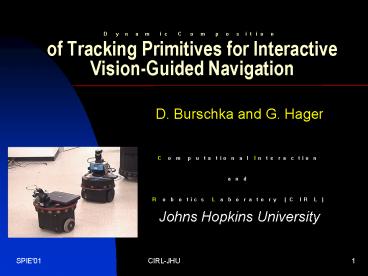Dynamic Composition of Tracking Primitives for Interactive Vision-Guided Navigation - PowerPoint PPT Presentation
Title:
Dynamic Composition of Tracking Primitives for Interactive Vision-Guided Navigation
Description:
Title: Vision-Based Control of Mobile Robots Author: Darius Burschka Last modified by: Darius Burschka Created Date: 1/1/1601 12:00:00 AM Document presentation format – PowerPoint PPT presentation
Number of Views:82
Avg rating:3.0/5.0
Title: Dynamic Composition of Tracking Primitives for Interactive Vision-Guided Navigation
1
Dynamic Composition of Tracking Primitives for
Interactive Vision-Guided Navigation
- D. Burschka and G. Hager
- Computational Interaction
- and
- Robotics Laboratory (CIRL)
- Johns Hopkins University
2
Outline
- Introduction
- Motivation Navigation Strategies
- Tracking-System Architecture
- Pre-Processing
- New Tracking Definition
- Feature Identification
- Results
- Conclusions
3
Navigation Strategies
Map-Based Navigation pre-processed sensor
data is stored in a geometrical
representation of the envi- ronment (map).
Path plan- ningstrategy algorithms are
used to define the actions of the robot
Sensor-Based Control control signals for the
robot are generated directly from the
visual input
4
Tracking Primitives
Disparity tracking
Color Tracking
Pattern Tracking
Dynamic Vision (XVision)
algorithms
5
XVision as Tracking Tool
Dynamic Vision (XVision)
algorithms
applications
6
Tracking-System Architecture
7
Dynamic Composition of Tracking Cues
8
Tracking-System Architecture
9
Segmentation in the ColorSpace
Hue
Saturation
Intensity
- HSI representation of color space -
Variable resolution gridding of space
10
Segmentation in the Disparity Domain
11
Tracking-System Architecture
12
State Transitions in the Tracking Process
13
State Information saved in the Tracking Module
- Information about the object in the real
scene is shared between the different Image
Identifications - Position in the image
- Size of the region
- Range in the current image domain
- Shape ratio in the image
- Compactness of the region
14
Tracking-System Architecture
15
Quality Value for Initial Search
16
Problem in the Disparity Domain
17
Ground Plane Suppression
18
Results Obstacle Detection
19
Results Dynamic Composition
20
Conclusions and Future Work
- Dynamic Composition of the two Basic Feature
Identification tools allowed robust initial
selection and navigation through a door - Extension to the entire set of Feature
Identification tools is our next step - The developed algorithms allow robust obstacle
avoidance
21
Additional Information
- Web
- http//www.cs.jhu.edu/CIRL
- http//www.cs.jhu.edu/burschka































